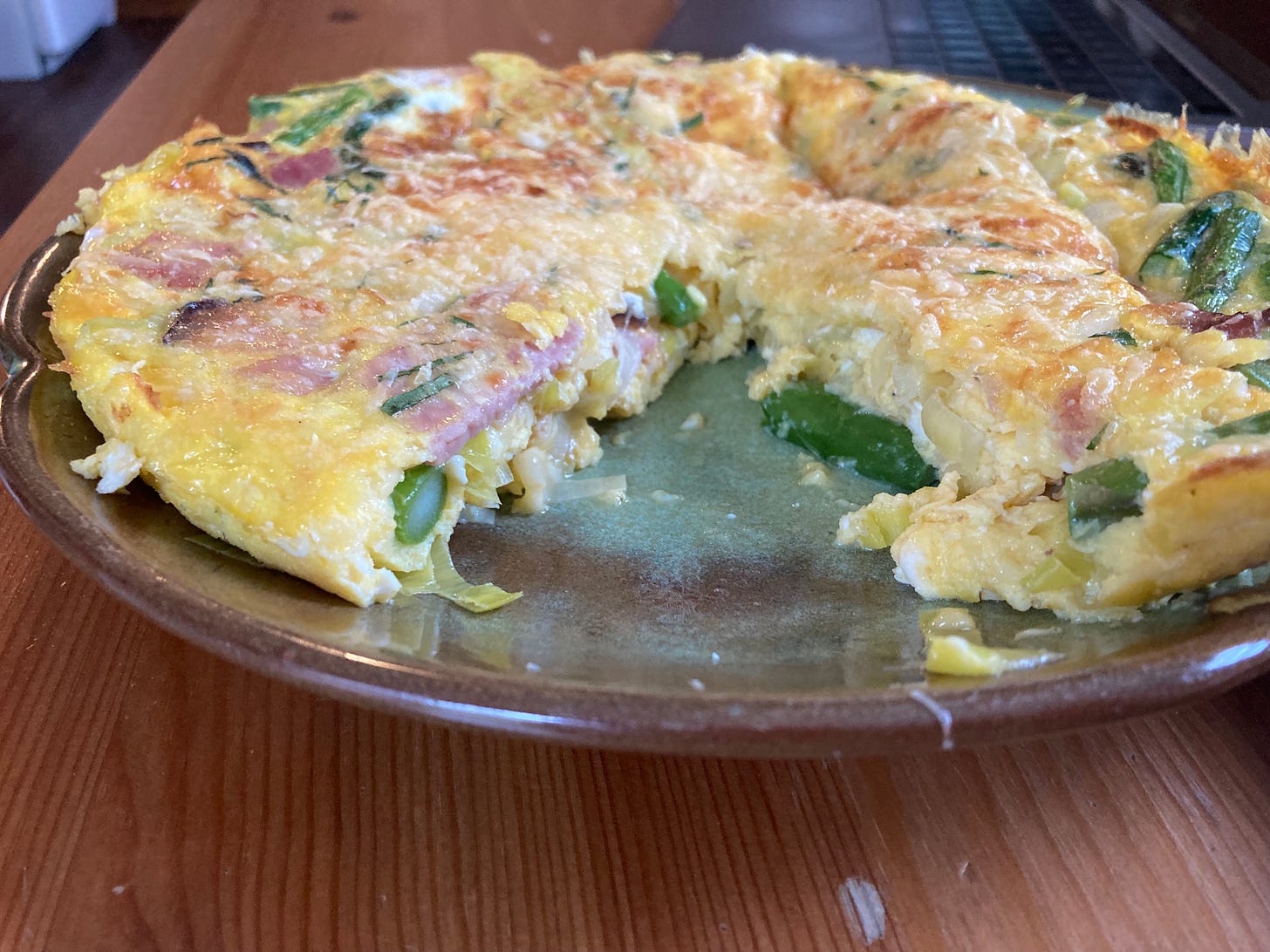My delightful and funny friend Polly Frost is always texting me photos of things she’s cooking. This is distressing because Polly is a very good cook, inventive and talented and willing to splash out on good ingredients and private cooking lessons, but she lives near the beach in Santa Barbara and I’m in Nashville, which means I must continually suffer the pains of Tantalus. I have eaten at Polly’s table and know what I am missing.
I do, however, have one thing Polly does not have, an asparagus patch. When we moved into our new home on St. Patrick’s Day, two years ago, I immediately got to work with a shovel digging trenches for asparagus. Thanks to the COVID lockdown, I had plenty of time to do that. So, on the east side of my house, where there’s good morning light, I planted two kinds of asparagus crowns, the heirloom Mary Washington, and the modern hybrid cultivar Jersey Knight, the latter of which were two-year-old crowns, mail-ordered from Growers Solution in Cookeville, Tennessee.
Last year, one year after planting, the asparagus came up vigorously. I plucked a few spears in April, and then let them be for the rest of the year. They responded by turning into a dense thicket of asparagus ferns, where my skittish mini-Aussie, Sparky, sometimes took refuge from the people running power tools next door.
Right now, two years after planting, I’m being rewarded for my patience with asparagus. I’ve taken six or seven good bunches out of my patch already and will probably get three or four more before I let them go for the rest of the season. It’s three weeks of asparagus this year, so that I can get six weeks every year until I die.
Most of the asparagus I’ve picked has been flash-boiled in a skillet of salted water. Put the spears in cold water, turn it on high and give it two minutes after it reaches a strong boil. I like to eat them straight from the skillet with mayonnaise and lemon juice.
The other thing I’ve been doing with my asparagus is tossing them into frittatas. My wife has been buying eggs from a co-worker who lives in the country and has a flock of yard chickens. So, we seem to always have plenty of good eggs on hand.
The frittata I made yesterday was from leftover ham, leeks and asparagus, finished under the broiler with aged gouda. Here’s the recipe for that.
Ham, Leek and Asparagus Frittata
1 leek, white and pale green parts thinly sliced
1 cup of sliced ham
6 or 7 asparagus spears, sliced into 2” pieces.
3 tablespoons of butter
8 large eggs, beaten.
3/4 cup of grated cheese (see below)
1/4 cup of grated aged gouda
Melt two tablespoons of butter in a 12” frying pan on medium high heat, then add the sliced leek. Cook until soft, about five minutes. Add the asparagus and cook for two or three minutes.
Melt another tablespoon of butter into the pan and then add the ham and the beaten eggs. Add a half cup of grated cheese and stir gently to make sure that everything is evenly distributed.
Then turn the heat down to its next-to-lowest setting and wait. The trick is to get the eggs to firm up on low heat but keep the top semi-liquid, which will take five to ten minutes. Sorry I can’t be more precise. You’ll have to eyeball it.
When the eggs are set but the top is still a little liquidy, grate a generous amount of gouda onto the top of the frittata, then put the pan under a broiler set to its highest heat and cook for about three minutes, or until the top is puffy and golden brown.
Et voila!
The eggs in the middle were creamy, but it needed more asparagus. Otherwise, it was delicious.
A couple of notes about this frittata. One, yes, that is Easter’s leftover spiral-sliced Honey Baked Ham. We had half a ham. There were five of us for Easter, one of whom was a pescatarian, which means we’ll be eating that ham until, approximately, the sun goes supernova, give or take. Luckily, I really like Honey Baked Hams.
Two, I cheated on the base cheese. Rather than use emmentaler, fontina or mozzarella, I grabbed this out of the refrigerator.
Pre-shredded Mexican quesadilla cheese is a perfectly fine, neutral-tasting cheese. (Great for melting!) I’ve used this for two frittatas in the past week, and both times the result was delicious. I did, of course, grate a good, aged gouda onto it before broiling, and the flavor of that really came through in the finished dish.
Three, I forgot to mention that I grabbed a sprig of fresh oregano from the herb garden, chiffonaded a few leaves and sprinkled them on top just before broiling. It wasn’t necessary, but it worked.
Four, if I were using store-bought asparagus, instead of just picked, I’d probably parboil the asparagus before putting it in the frittata. Fresh asparagus are marvelously tender.
Five, this needed more asparagus. We ate a big bunch of asparagus on Saturday, and it’s been chilly since then, so my asparagus production has slowed down, hence the pitiful six spears you see above. I think 10 or 12 would have been better.
But, that’s the great thing about owning your own asparagus patch, for a few glorious weeks in the spring, there’s always more where that came from! And, now, I have to go ask Polly what she would do with fresh asparagus.
P.S. Julia Watson, whose newsletter you should subscribe to, has a short piece on the history of asparagus that’s worth your time.
Thanks for reading! I’ll see you again on Monday with something new. In the meantime, follow me on Twitter and Instagram.












We have a hard time deciding between eating immediately after harvesting, whilst still in the garden, or broiling within minutes at 550 for about 90 seconds with a slight olive oil coating and a parmesan based sprinkling.
Nothing like a healthy asparagus patch once established; we plan our trips around the anticipated harvest weeks!
Plus an awfully cute and hungry dog.